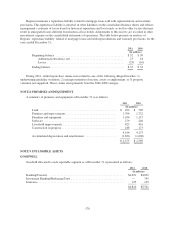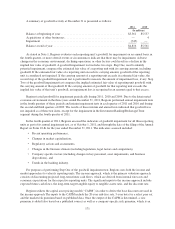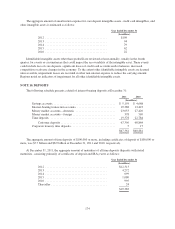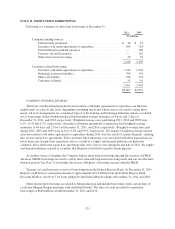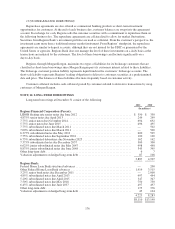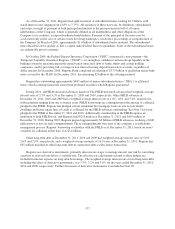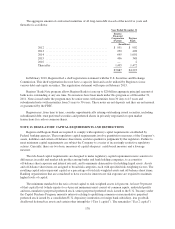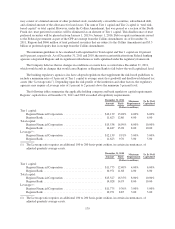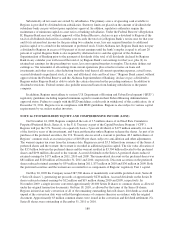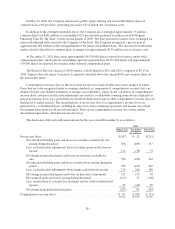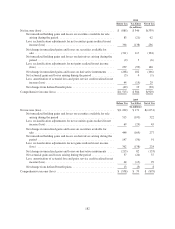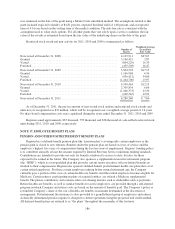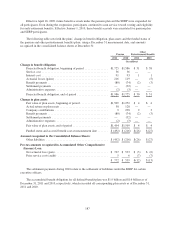Regions Bank 2011 Annual Report Download - page 201
Download and view the complete annual report
Please find page 201 of the 2011 Regions Bank annual report below. You can navigate through the pages in the report by either clicking on the pages listed below, or by using the keyword search tool below to find specific information within the annual report.As of December 31, 2011, Regions had eight issuances of subordinated notes totaling $3.3 billion, with
stated interest rates ranging from 4.85% to 7.75%. All issuances of these notes are, by definition, subordinated
and subject in right of payment of both principal and interest to the prior payment in full of all senior
indebtedness of the Company, which is generally defined as all indebtedness and other obligations of the
Company to its creditors, except subordinated indebtedness. Payment of the principal of the notes may be
accelerated only in the case of certain events involving bankruptcy, insolvency proceedings or reorganization of
the Company. In March of 2011, approximately $1.0 billion of subordinated notes matured. The subordinated
notes described above qualify as Tier 2 capital under Federal Reserve guidelines. None of the subordinated notes
are redeemable prior to maturity.
In October 2008, the Federal Deposit Insurance Corporation (“FDIC”) announced a new program—the
Temporary Liquidity Guarantee Program (“TLGP”)—to strengthen confidence and encourage liquidity in the
banking system by guaranteeing newly issued senior unsecured debt of banks, thrifts and certain holding
companies, and by providing full coverage of non-interest bearing deposit transaction accounts, regardless of
dollar amount. In December 2008, Regions Bank completed an offering of $3.75 billion of qualifying senior bank
notes covered by the TLGP. In December 2011, the remaining $2 billion of this offering matured.
Regions has outstanding approximately $843 million of junior subordinated notes (“JSNs”) to affiliated
trusts, which contemporaneously issued trust preferred securities which Regions guaranteed.
During 2011, all FHLB structured advances matured. The FHLB structured advances had weighted-average
interest rates of 2.5% and 3.1% at December 31, 2010 and 2009, respectively. Other FHLB advances at
December 31, 2011, 2010 and 2009 had a weighted-average interest rate of 1.0%, 1.0% and 3.4%, respectively,
with maturities ranging from one to twenty years. FHLB borrowings are contingent upon the amount of collateral
pledged to the FHLB. Regions has pledged certain residential first mortgage loans on one-to-four family
dwellings and home equity lines of credit as collateral for the FHLB advances outstanding. See Note 5 for loans
pledged to the FHLB at December 31, 2011 and 2010. Additionally, membership in the FHLB requires an
institution to hold FHLB stock, and Regions held $219 million at December 31, 2011 and $419 million at
December 31, 2010. During 2010, Regions prepaid approximately $2 billion of FHLB advances, realizing a $108
million pre-tax loss on early extinguishment. These extinguishments were part of the company’s asset/liability
management process. Regions’ borrowing availability with the FHLB as of December 31, 2011, based on assets
available for collateral at that date, was $5.4 billion.
Other long-term debt at December 31, 2011, 2010 and 2009 had weighted-average interest rates of 5.0%,
2.6% and 2.9%, respectively, and a weighted-average maturity of 10.9 years at December 31, 2011. Regions has
$55 million included in other long-term debt in connection with a seller-lessee transaction.
Regions uses derivative instruments, primarily interest rate swaps, to manage interest rate risk by converting
a portion of its fixed-rate debt to a variable-rate. The effective rate adjustments related to these hedges are
included in interest expense on long-term borrowings. The weighted-average interest rate on total long-term debt,
including the effect of derivative instruments, was 3.3%, 3.2% and 3.6% for the years ended December 31, 2011,
2010 and 2009, respectively. Further discussion of derivative instruments is included in Note 20.
177





